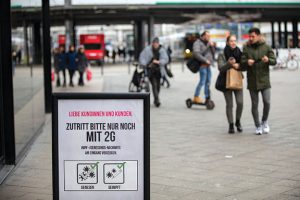Bloomberg
Chancellor Olaf Scholz said Germany could loosen some pandemic restrictions next week as the country’s outbreak shows signs of peaking.
While contagion rates are continuing to post records on a daily basis, the pace of the increases have slowed. Meanwhile, Covid-19 cases in intensive-care facilities are less than half the level in early December. That’s prompted calls for easing curbs.
“The scientific forecasts show that the peak of the wave is in sight,†Scholz said on Friday in a speech to the upper house of German parliament.
While countries such as the UK, Ireland and Denmark have drastically rolled back pandemic controls, Germany has been an outlier by maintaining restrictions on restaurants, shops and public gatherings, which mainly target unvaccinated people.
Scholz indicated he would continue to take a cautious approach, saying further steps to ease curbs might only come in the spring.
Meanwhile, German joblessness falls at a much faster pace than anticipated in January as the economy comes to terms with coronavirus curbs to
contain surging infections.
Unemployment in Europe’s largest economy declined by 48,000, pushing the jobless rate down to 5.1%. Economists had forecast a drop of just 6,000.
The numbers show the resilience of the German economy, which is now hampered by supply bottlenecks and higher prices.
While the labour market has largely managed to weather those challenges, the number of furloughed workers has been on the rise since November, estimates by the Ifo Institute show. In December, 2.6% of workers were on furlough in Germany, it said last month.
With infection numbers reaching new records, Germany has reintroduced restrictions on activity, targeting mainly unvaccinated people.
Still, German output contracted in the final quarter of last year and might not resume its recovery until the current virus wave passes.
Supply constraints are only beginning to ease gradually, and the spread of omicron in Asia raises the specter of a further setback for Germany’s key manufacturing sector. More shortages could continue to fuel price increases, with inflation proving unexpectedly strong in January.
 The Gulf Time Newspaper One of the finest business newspapers in the UAE brought to you by our professional writers and editors.
The Gulf Time Newspaper One of the finest business newspapers in the UAE brought to you by our professional writers and editors.
